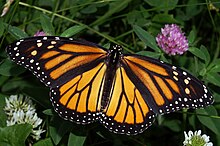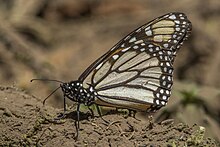| Monarch butterfly | |
|---|---|

| |
| Male | |

| |
| Female | |
| Scientific classification | |
| Domain: | Eukaryota |
| Kingdom: | Animalia |
| Phylum: | Arthropoda |
| Class: | Insecta |
| Order: | Lepidoptera |
| Family: | Nymphalidae |
| Genus: | Danaus |
| Species: | D. plexippus
|
| Binomial name | |
| Danaus plexippus | |

| |
| Synonyms | |


Piedra Herrada, Mexico
The monarch butterfly or simply monarch (Danaus plexippus) is a milkweed butterfly (subfamily Danainae) in the family Nymphalidae.[6] Other common names, depending on region, include milkweed, common tiger, wanderer, and black-veined brown.[7] It is among the most familiar of North American butterflies and an iconic pollinator,[8] although it is not an especially effective pollinator of milkweeds.[9] Its wings feature an easily recognizable black, orange, and white pattern, with a wingspan of 8.9–10.2 cm (3.5–4.0 in).[10] A Müllerian mimic, the viceroy butterfly, is similar in color and pattern, but is markedly smaller and has an extra black stripe across each hindwing.
The eastern North American monarch population is notable for its annual southward late-summer/autumn instinctive migration from the northern and central United States and southern Canada to Florida and Mexico.[6] During the fall migration, monarchs cover thousands of miles, with a corresponding multigenerational return north in spring. The western North American population of monarchs west of the Rocky Mountains often migrates to sites in southern California, but individuals have been found in overwintering Mexican sites, as well.[11][12] Non-migratory populations are found further south in the Americas, and in parts of Europe, Oceania, and Southeast Asia.
- ^ Walker, A.; Thogmartin, W. E.; Oberhauser, K. S.; Pelton, E. M.; Pleasants, J. M. (2022). "Danaus plexippus". IUCN Red List of Threatened Species. 2022: e.T159971A806727. doi:10.2305/IUCN.UK.2022-1.RLTS.T159971A806727.en. Retrieved December 6, 2022.
- ^ "Migratory Monarch Butterfly". IUCN Red List of Threatened Species.
- ^ Cite error: The named reference
RoyEntSocwas invoked but never defined (see the help page). - ^ Cite error: The named reference
Scudderwas invoked but never defined (see the help page). - ^ Moore (1883). "Anosia plexippus". Proceedings of the Zoological Society of London: 234–235. (Cited in Scudder, Samuel Hubbard; Davis, William M.; Woodworth, Charles W.; Howard, Leland O.; Riley, Charles V.; Williston, Samuel (1889). The Butterflies of the Eastern United States and Canada: With Special Reference to New England: Anosia plexippus - The Monarch. Vol. 1. Cambridge, Massachusetts: The author. p. 720. doi:10.5962/bhl.title.9161. ISBN 978-0-665-26322-4. LCCN 06021638. OCLC 2604754. Retrieved December 27, 2023 – via HathiTrust.)
- ^ a b Agrawal, Anurag (March 7, 2017). Monarchs and Milkweed: A Migrating Butterfly, a Poisonous Plant, and Their Remarkable Story of Coevolution. Princeton University Press. ISBN 9781400884766.
- ^ Cite error: The named reference
nic.funet.fiwas invoked but never defined (see the help page). - ^ "Conserving Monarch Butterflies and their Habitats". USDA. 2015.
- ^ Multiple sources:
- Jones, Patricia L.; Agrawal, Anurag A. (2016). "Consequences of toxic secondary compounds in nectar for mutualist bees and antagonist butterflies". Ecology. 97 (10): 2570–2579. Bibcode:2016Ecol...97.2570J. doi:10.1002/ecy.1483. hdl:1813/66741. ISSN 1939-9170. PMID 27859127.
- MacIvor, James Scott; Roberto, Adriano N.; Sodhi, Darwin S.; Onuferko, Thomas M.; Cadotte, Marc W. (2017). "Honey bees are the dominant diurnal pollinator of native milkweed in a large urban park". Ecology and Evolution. 7 (20): 8456–8462. Bibcode:2017EcoEv...7.8456M. doi:10.1002/ece3.3394. ISSN 2045-7758. PMC 5648680. PMID 29075462.
- ^ Cite error: The named reference
Garberwas invoked but never defined (see the help page). - ^ Cite error: The named reference
Grothwas invoked but never defined (see the help page). - ^ Cite error: The named reference
JointVenturewas invoked but never defined (see the help page).

